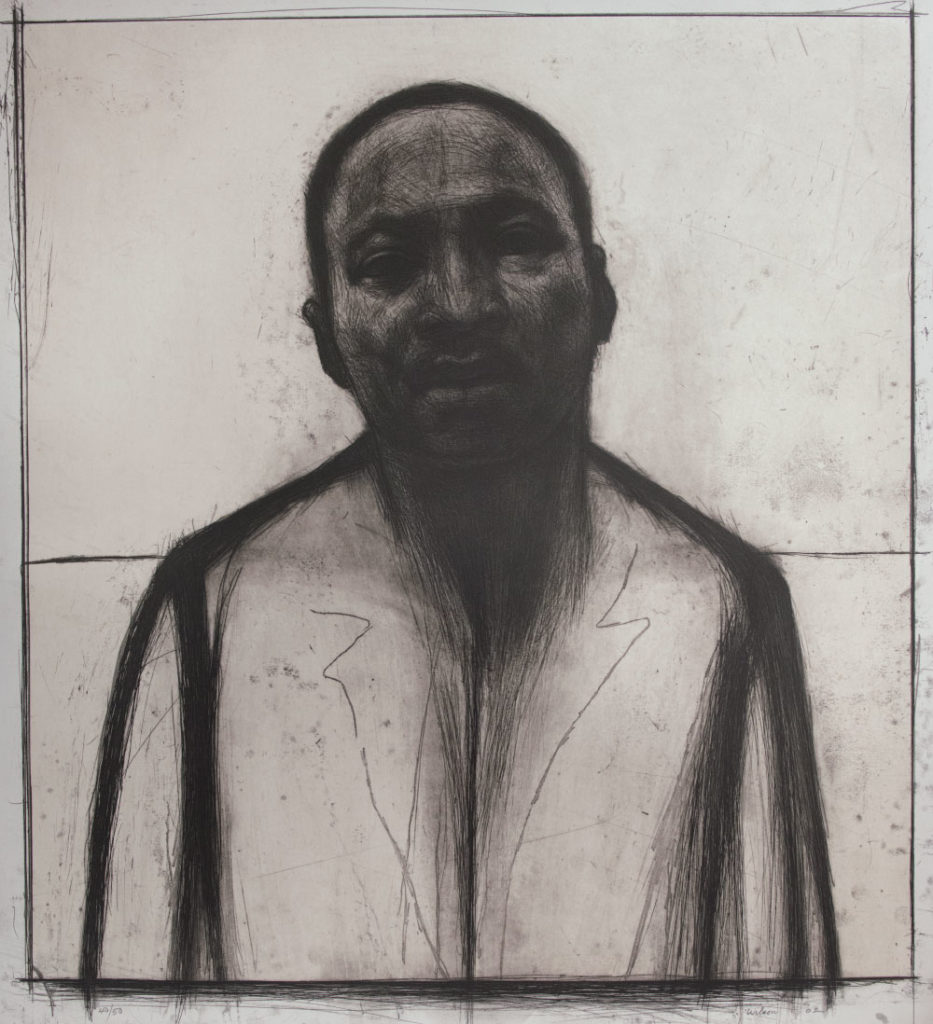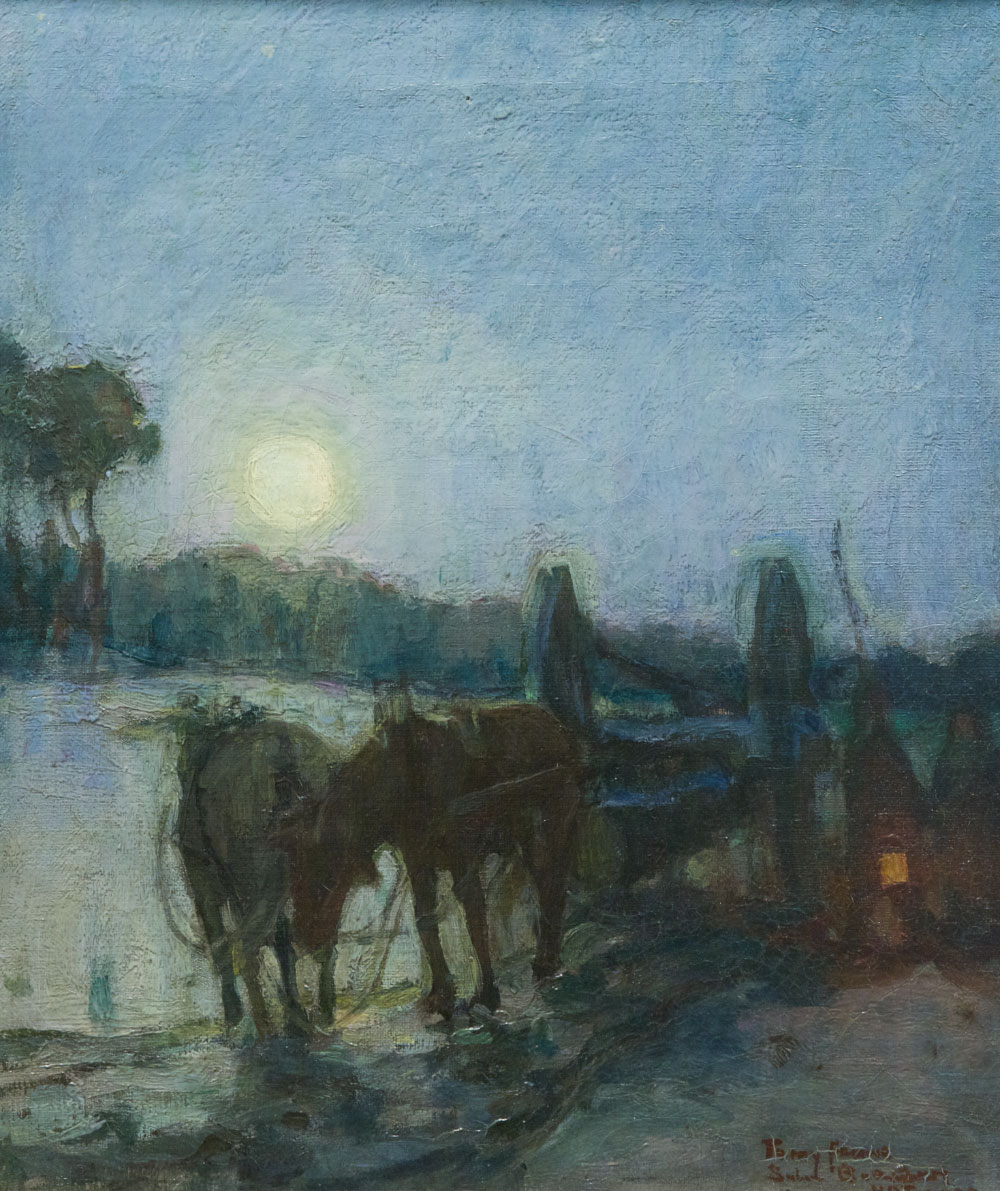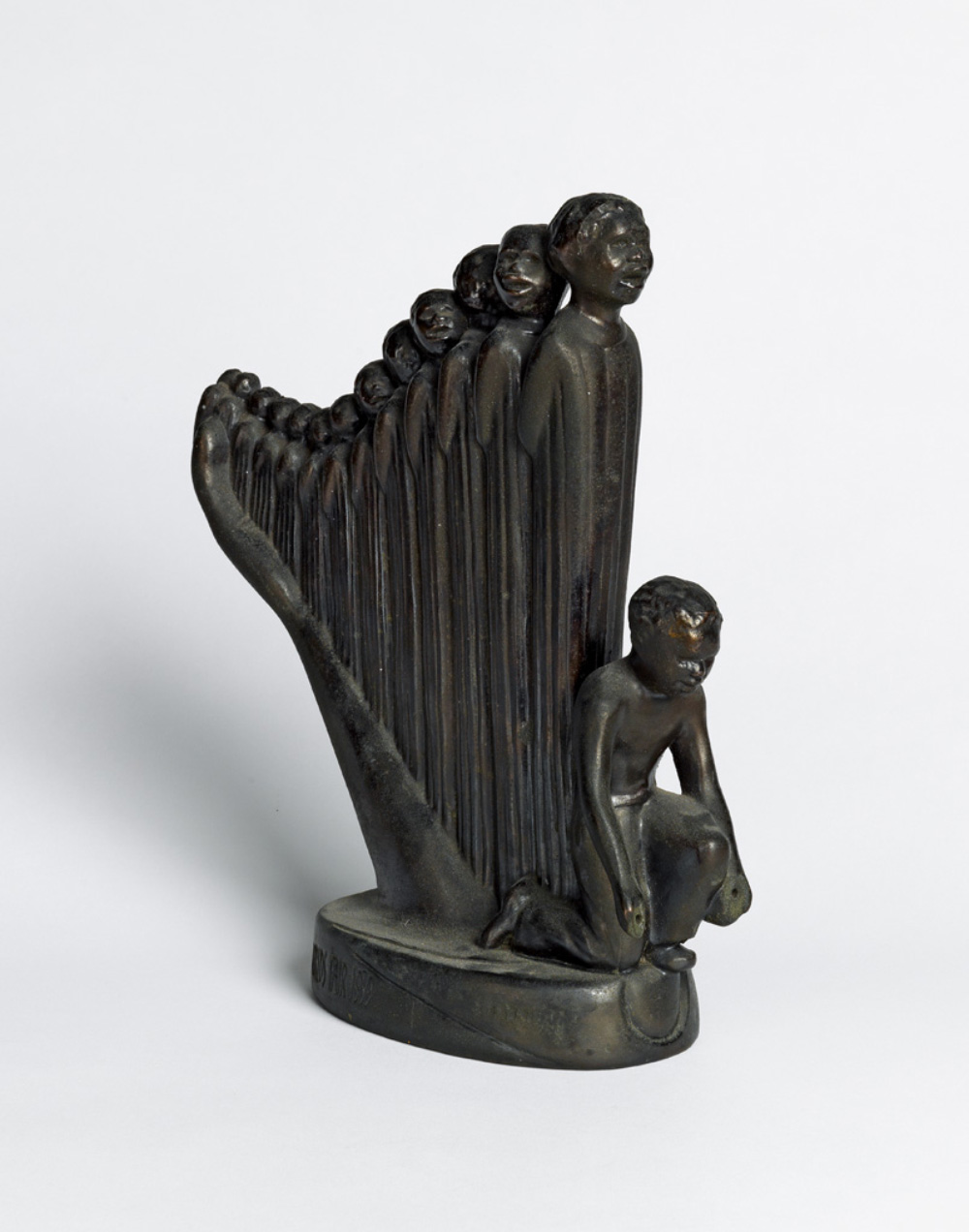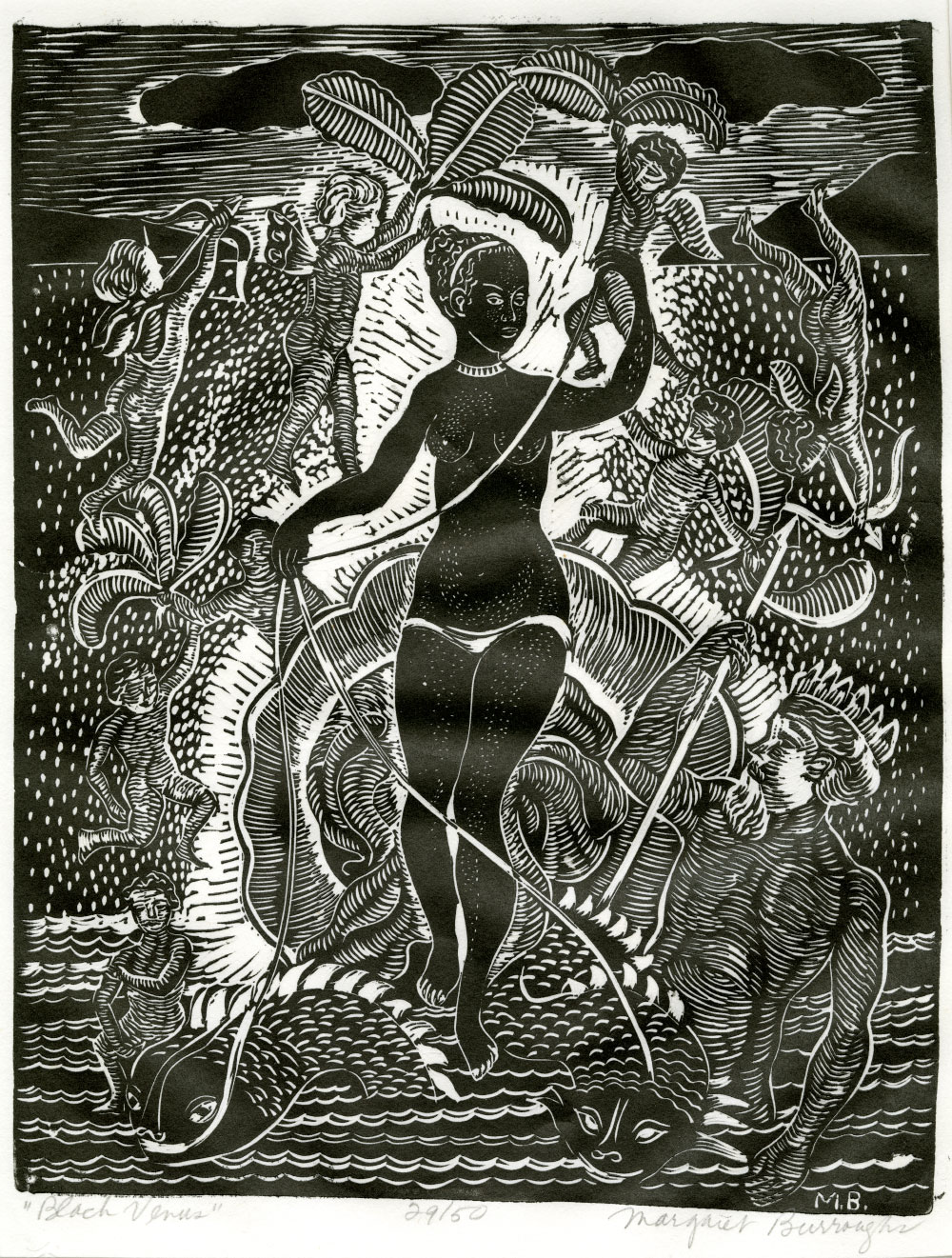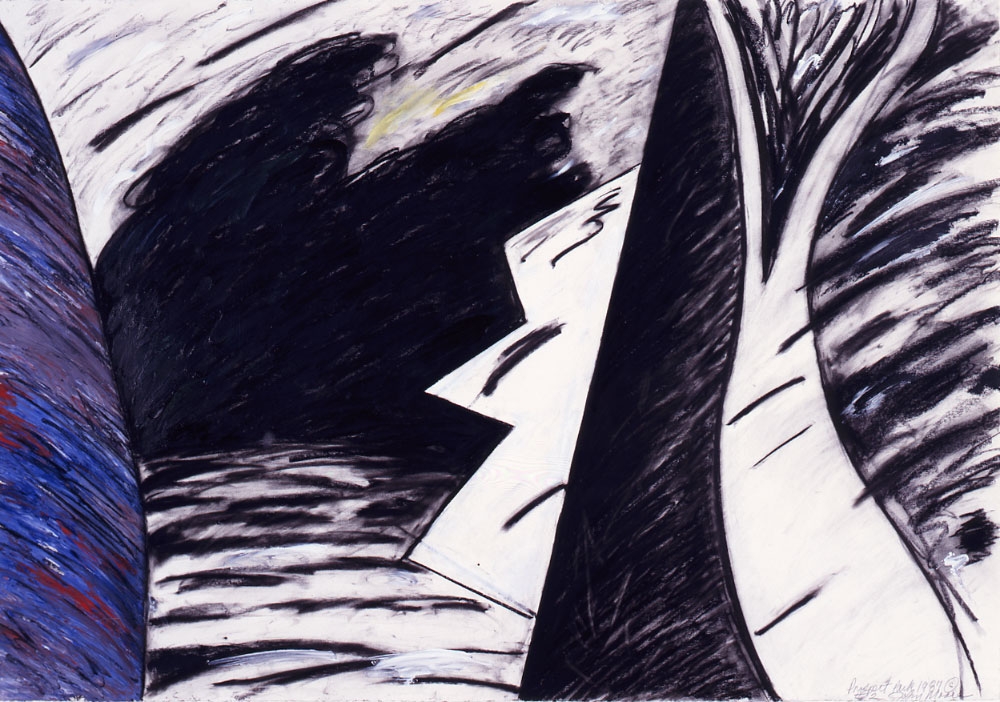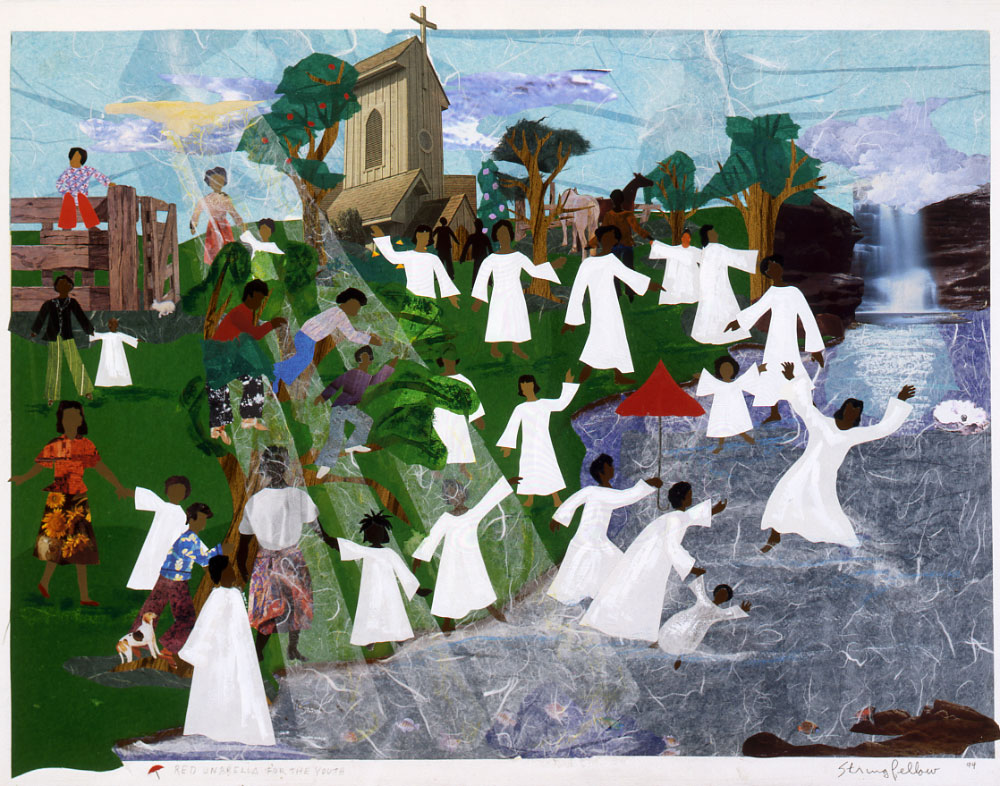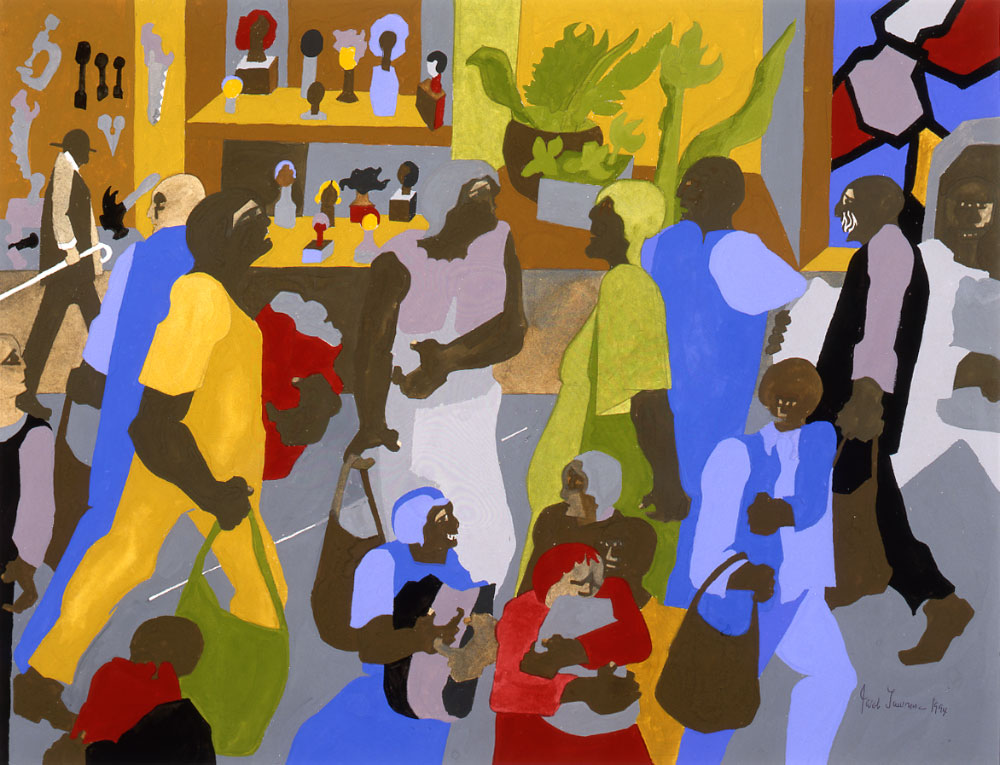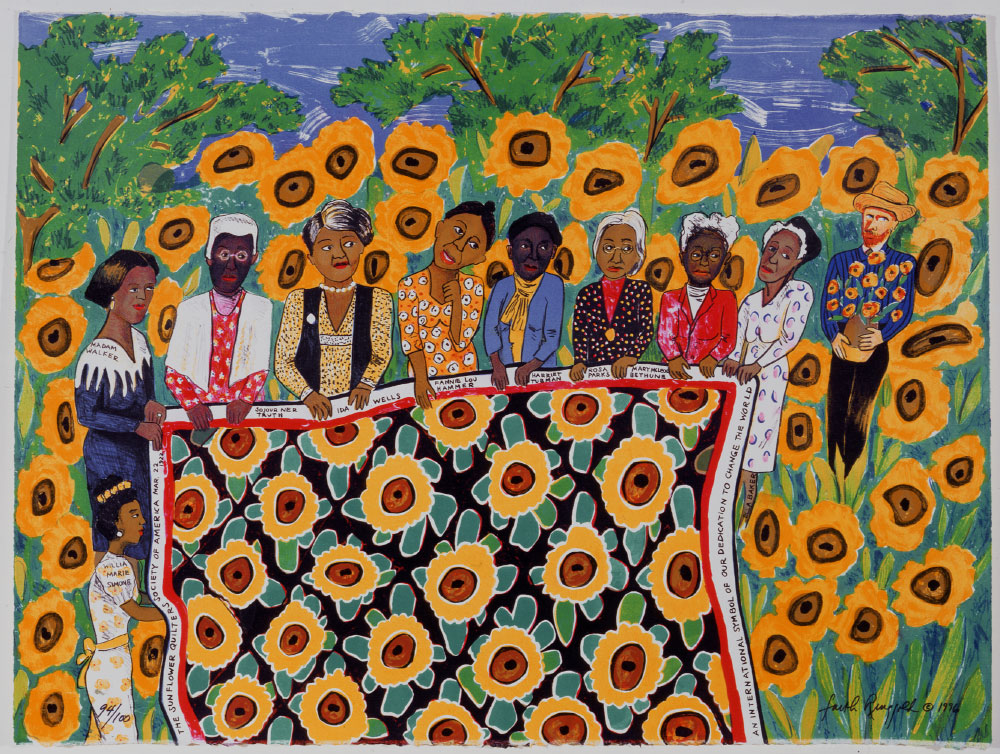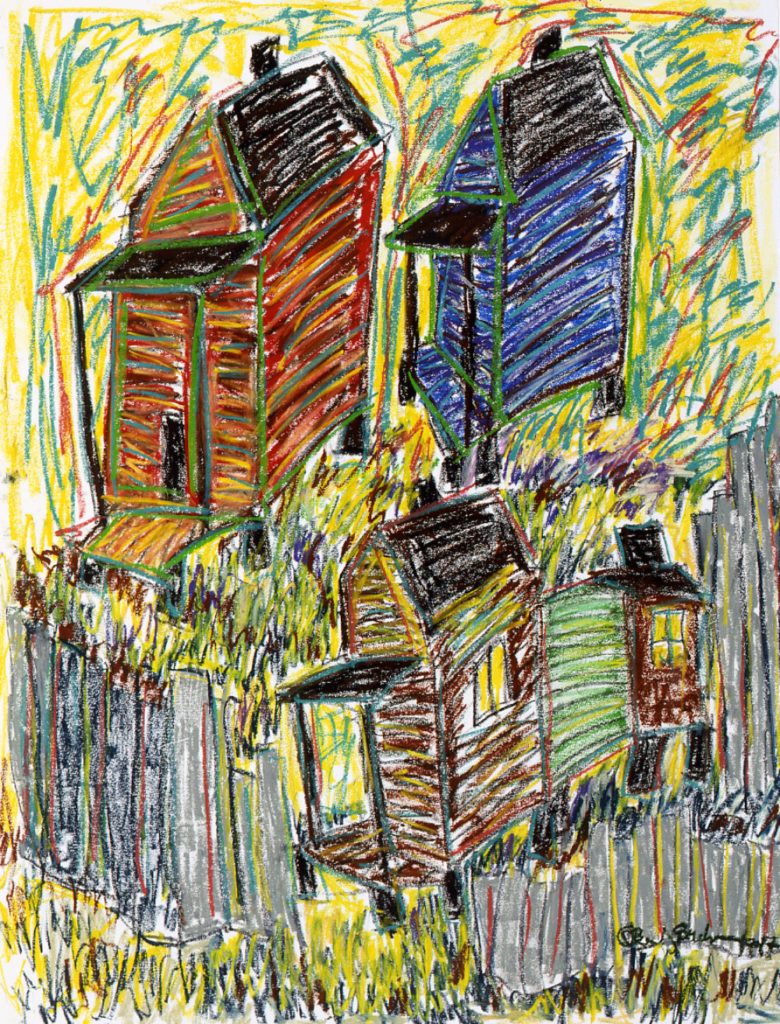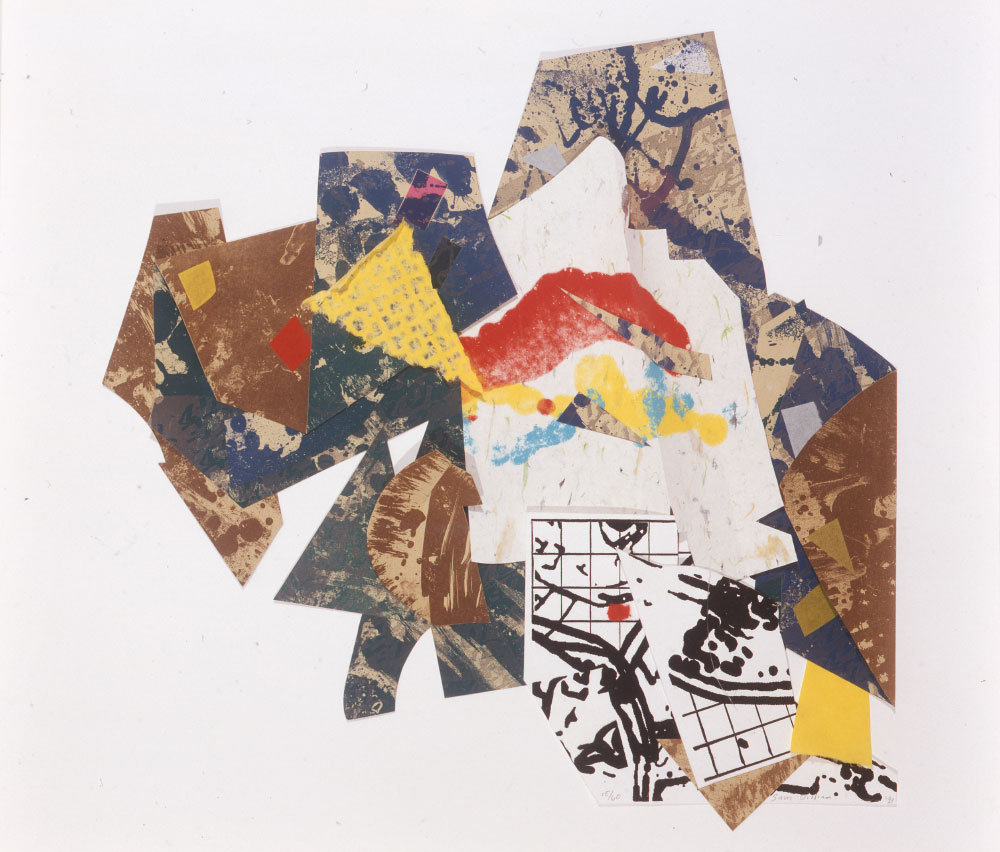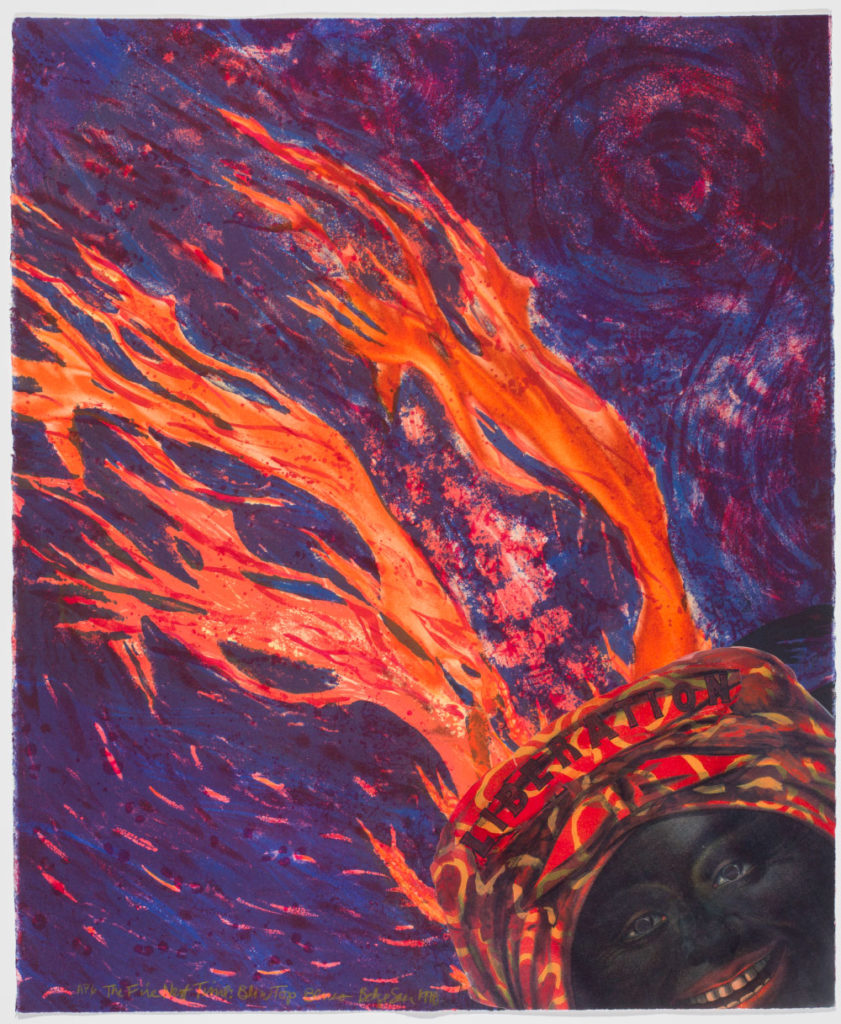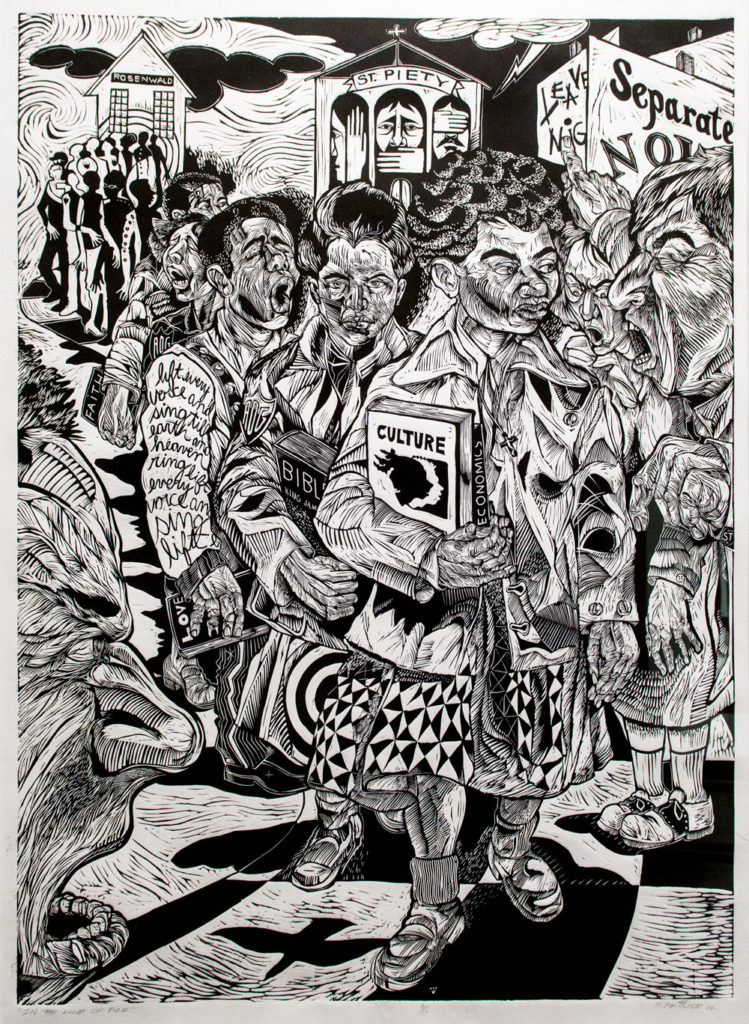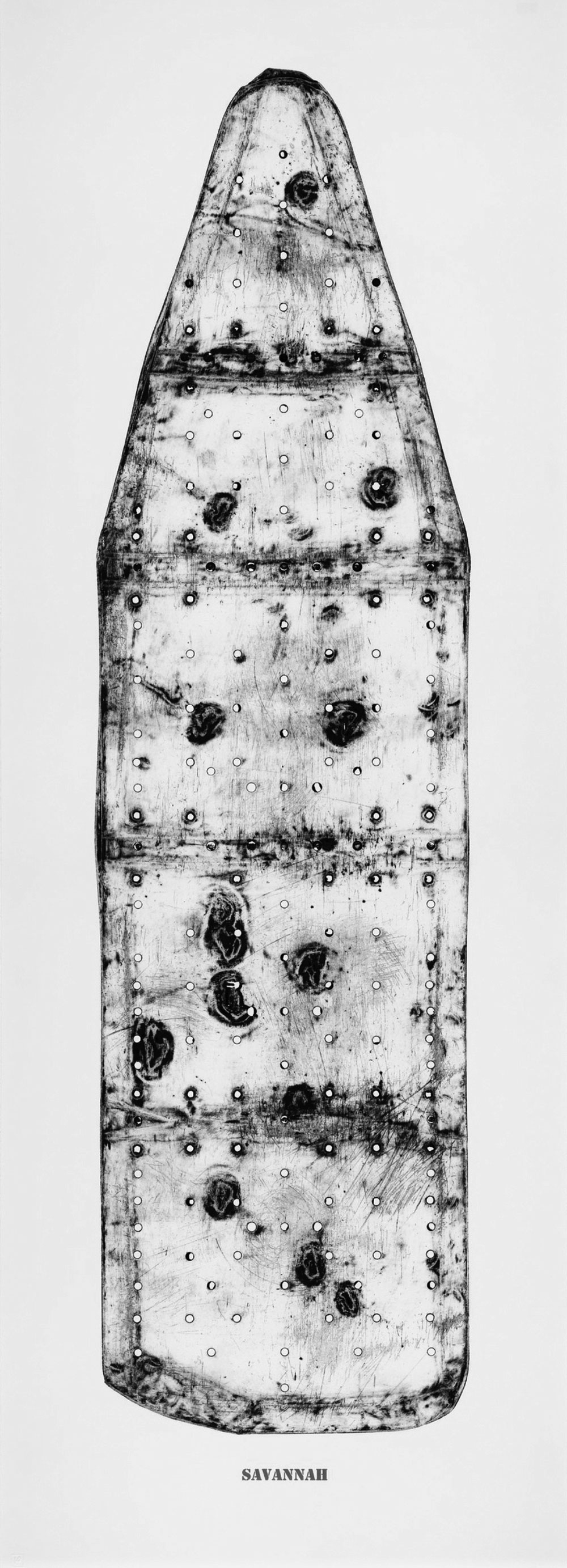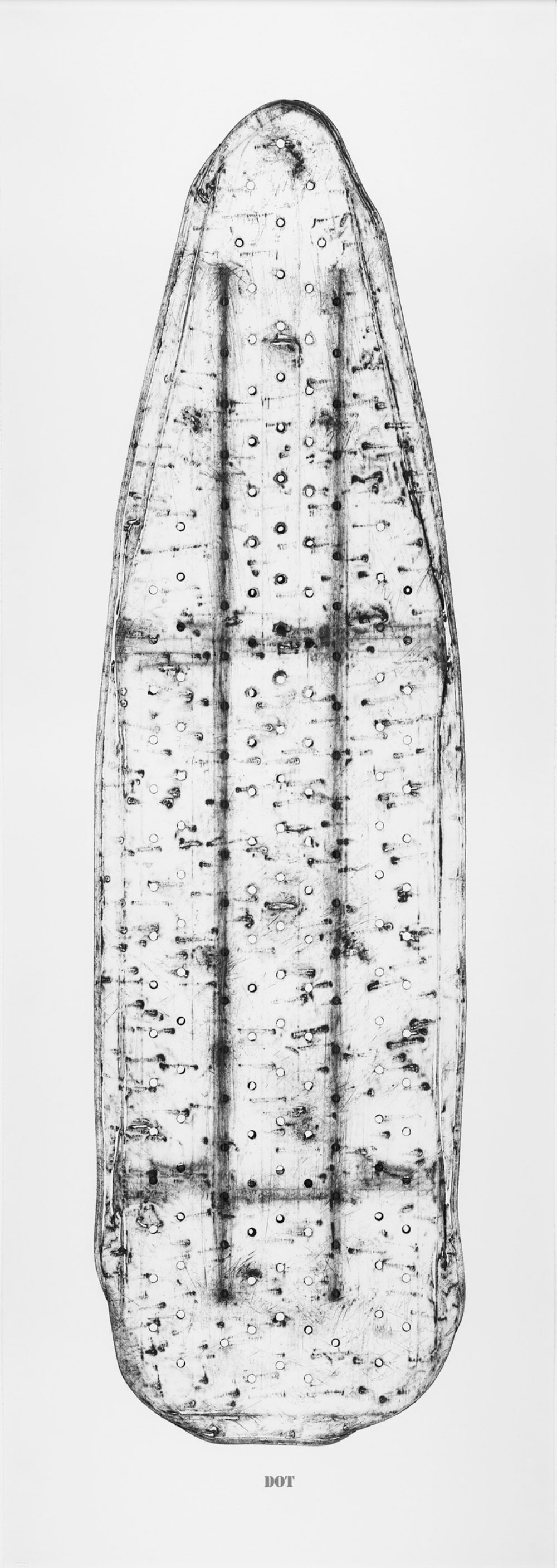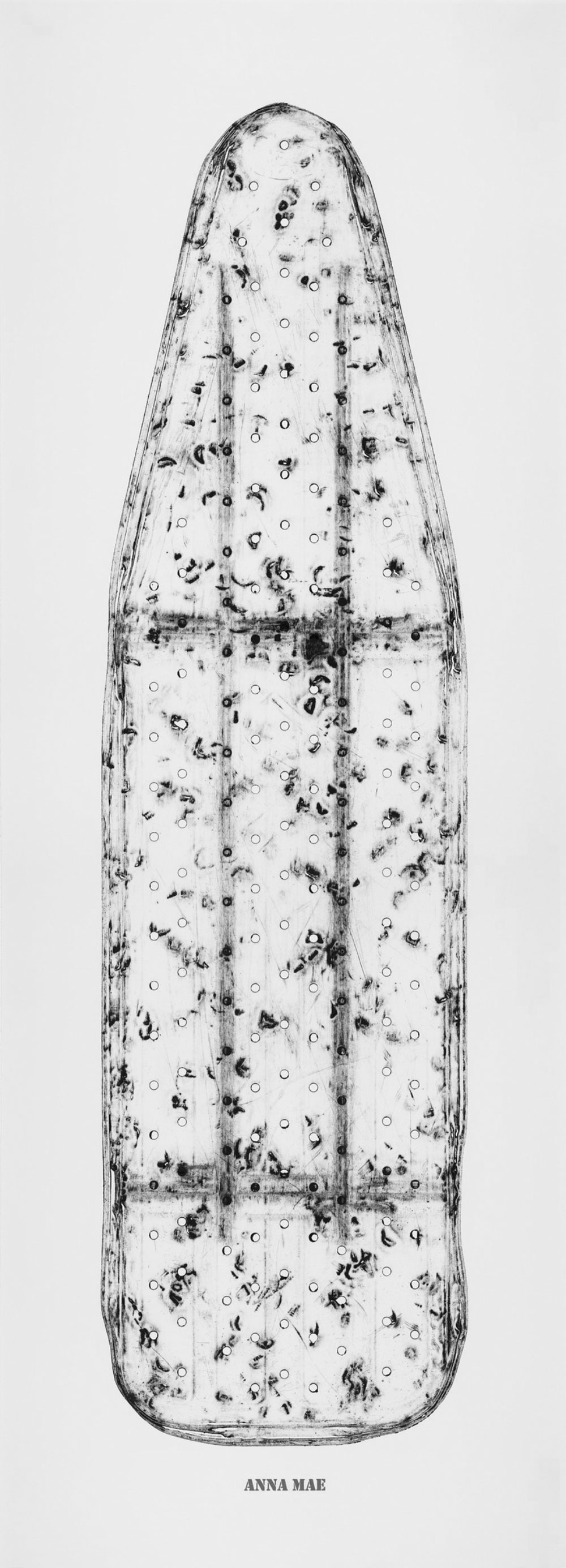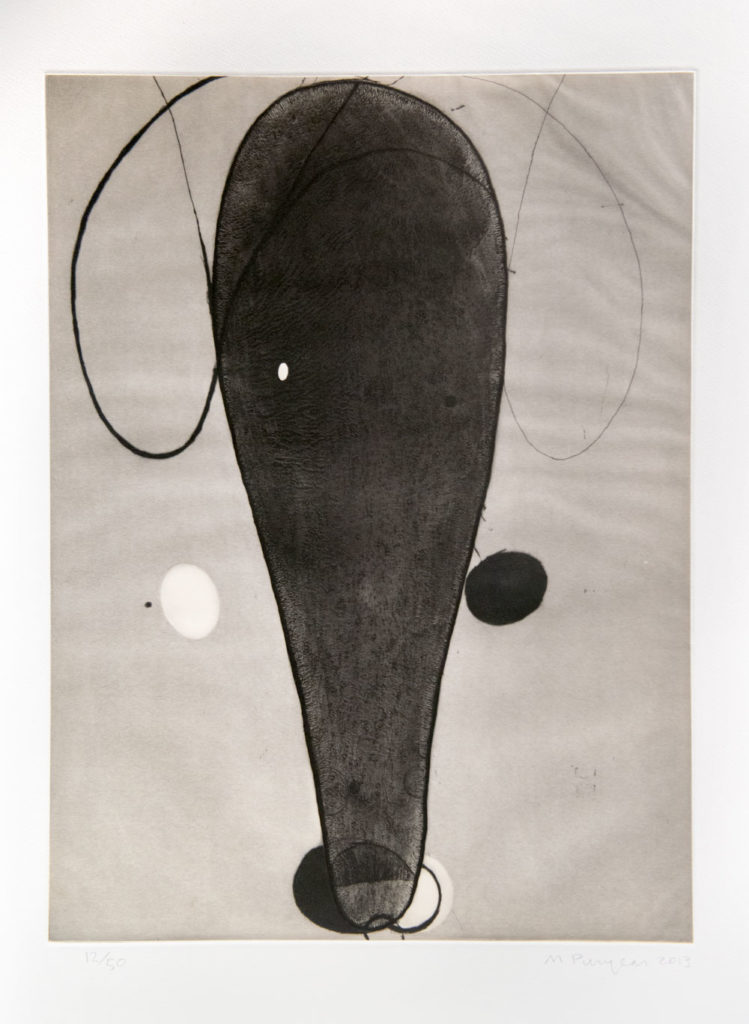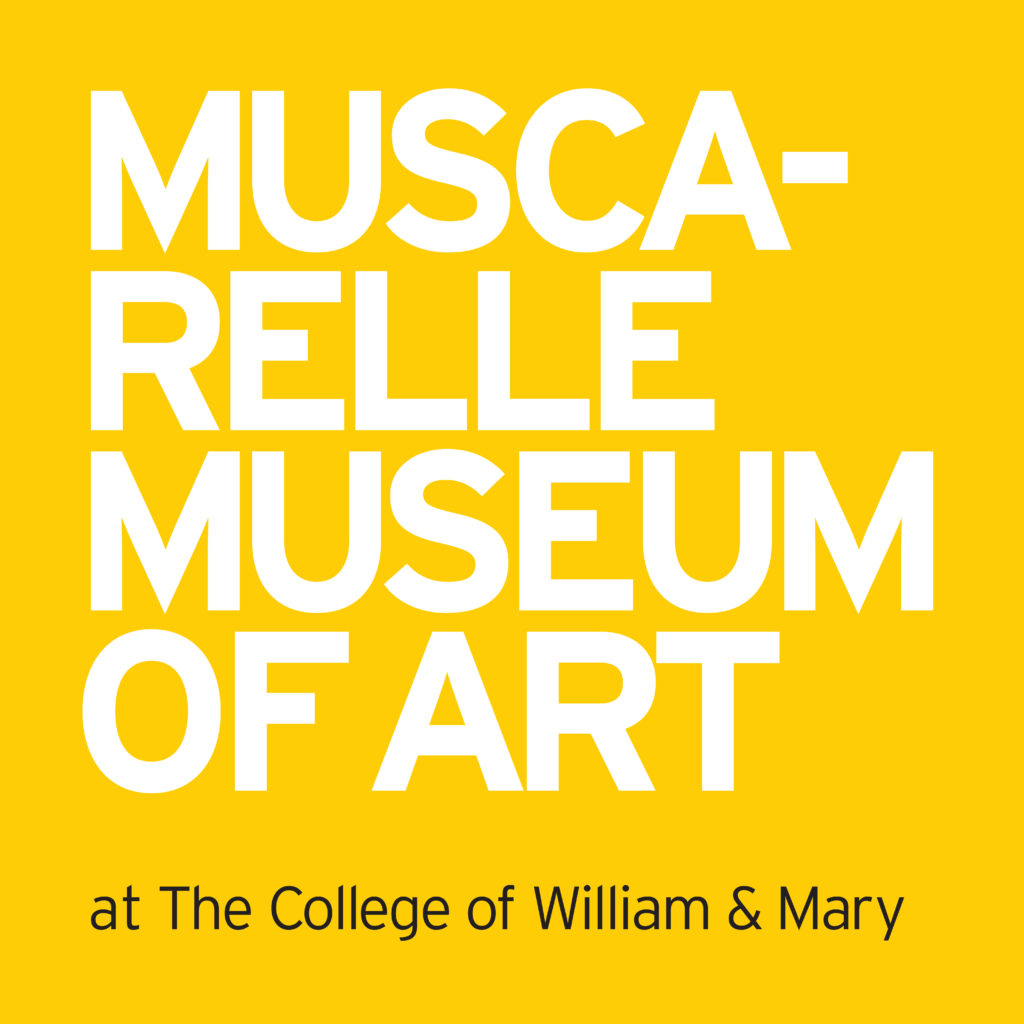Building on the Legacy
African American Art from the Permanent Collection
Created to commemorate the 50th anniversary of the first African American students in residence at William & Mary, Building on the Legacy: African American Art from the Permanent Collection was part of a yearlong program of special events during the 2017–2018 academic year, which spoke to themes of parity and desegregation.
The original exhibition, held at the Muscarelle Museum of Art (September 2, 2017 – January 14, 2018), featured works that encompassed a variety of media, styles and eras, exemplifying the plurality of vision among these accomplished artists.
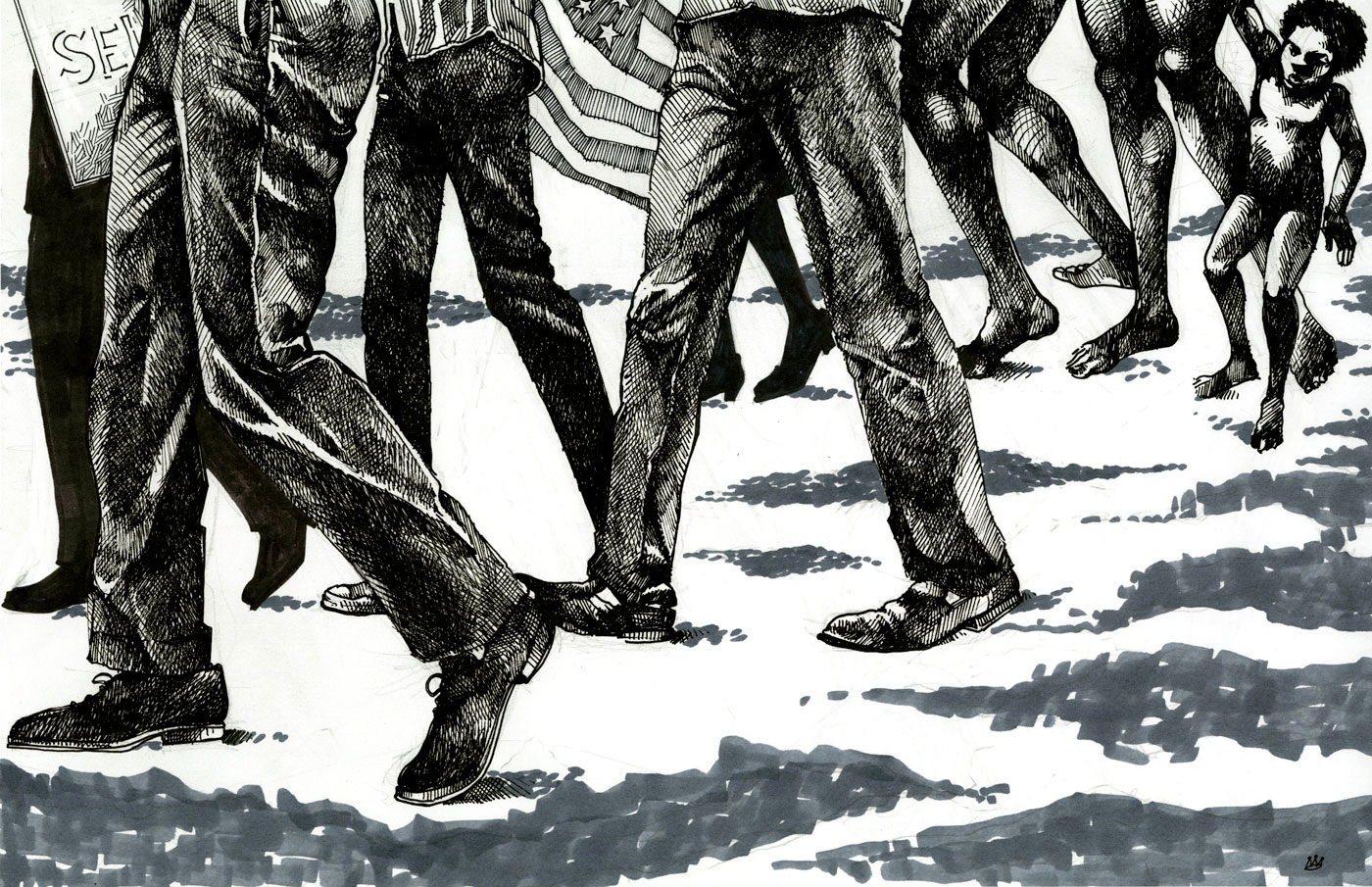
Original drawing by Steve Prince, 2019.
2019 marks the 400th year since the arrival of the first documented enslaved Africans in the Colony of Virginia. This history set into motion a legacy of racial exclusion that continues to affect our country hundreds of years later.
Re-created and expanded for VIRTUAL MUSCARELLE as part of the 2019 commemoration in the Commonwealth, Building on the Legacy embraces a panoply of approaches, ranging from the 19th – century realism of Henry Ossawa Tanner to the contemporary conceptualism of Martin Puryear.
Many artists in Building on the Legacy explore themes of segregation, stereotypes, intolerance and forced migration, which is fitting for the greater dialogue surrounding 2019.
“You couldn’t possibly grow up a black person without understanding the conflicts and anxieties in King. A calm and serene presence—but conflicts, worries inside.”
JOHN WILSON
JOHN WILSON
American, 1922 – 2015
Martin Luther King, Jr., 2002
Etching on chine collé, 40/50
30 3/4 x 27 3/8 ins. (76.5 x 69.6 cm)
© Estate of the artist
Acquired with funds from the Board of Visitors
Muscarelle Museum of Art Endowment
2015.011
Explore
Born in 1922, John Woodrow Wilson studied art at a young age when he took classes at the Museum of Fine Arts in Boston. Because of his skills as a draughtsman, he later received a scholarship to study with the German artist Karl Zerbe who had been labeled a degenerate artist by the Nazis. Wilson’s main objective as an artist was to share his beliefs about black dignity and the need for social justice. His works combine elements of strength and confidence and human tenderness as a response to violence and chaos. Wilson received many national awards and his works are found in important museums around the world.This powerful portrait of Martin Luther King, Jr. is based on the artist’s bronze bust of Dr. King, which was installed on a pedestal in the Rotunda of the Capitol building in Washington, D.C. in 1986. The isolation of the figure in space, the simple clothes contrasted with the deep shadows create a mood of profound and almost mysterious spirituality. The features of the face here are more individual than in the Rotunda bronze, which is more symmetrical, polished and monumental in effect. The aquatint has been made in a way to replicate the strokes and stray touches of a large, original drawing.
“I decided on the spot that I would be an artist, and I assure you, it was no ordinary artist I had in mind.”
HENRY OSSAWA TANNER
HENRY OSSAWA TANNER
American, 1859 – 1937
Moonlit Landscape, c. 1898 – 1900
Oil on canvas
18 1/8 x 15 1/4 ins. (46.4 x 38.4 cm)
Purchase, Gene A. (W&M 1952) and Mary A. Burns Art Acquisition Fund
Muscarelle Museum of Art
1997.114
Explore
The son of a former slave and an African Methodist bishop, Henry Ossawa Tanner spent his formative years in Philadelphia. At the age of twenty-one, he enrolled in the prestigious Pennsylvania Academy of Fine Arts, where he was a pupil of the leading American Realist painter Thomas Eakins. Despite his prodigious talent, Tanner was unable to establish a career in the United States as a result of racial prejudice. Consequently, he traveled to Paris in 1891 and studied at the famed Académie Julien. He exhibited regularly at the Paris Salons, winning a gold medal in 1897, and he was made a Chevalier of the Legion of Honor in 1923. Four years later, he became the first African American artist elected to the National Academy of Design, finally earning the recognition at home that he enjoyed abroad. Tanner remained in France until the end of his life.
“I have created nothing really beautiful, really lasting, but if I can inspire one of these youngsters to develop the talent I know they possess, then my monument will be their work.”
AUGUSTA SAVAGE
AUGUSTA SAVAGE
American, 1892 – 1962
Lift Every Voice and Sing, c. 1939
White metal cast with black patina
10 3/4 x 9 1/2 x 4 ins. (27.4 x 24.2 x 10.2 cm)
© Estate of Augusta Savage
Acquired with funds from the Board of Visitors
Muscarelle Museum of Art Endowment
2016.233
Explore
Born Augusta Christine Fells in Florida in 1892, Savage began making art at an early age using natural clay to create hand built sculptures. Her father was a Methodist minister and did not approve of her inclination to make art and dissuaded her verbally and physically. Nonetheless, she persisted and moved to New York where she studied at The Cooper Union School of Art. After obtaining commissions to create sculpture busts of influential African Americans including W.E.B. Du Bois and Marcus Garvey, Savage soon became one of the leading artists of the Harlem Renaissance. She was also an influential art educator and activist. In 1939, she was commissioned to create a sculpture for the New York World’s Fair. Inspired by James Weldon Johnson’s anthem Lift Every Voice and Sing, she produced a sixteen foot tall group of stylized singers in graduated heights that fanned out to symbolize the strings of a harp. Considered one of her most important works, this monumental sculpture was destroyed at the end of the fair. From her studio on West 125th Street, Savage cast a number of souvenir versions such as this one.
“I wish my art to speak not only for my people, but for all humanity.”
MARGARET BURROUGHS
MARGARET BURROUGHS
American, 1917 – 2010
Black Venus, 1957
Linoleum cut on imitation Japan paper
14 x 11 1/8 ins. (35.8 x 28.2 cm)
© Estate of Margaret Burroughs
Acquired with funds from the Board of Visitors
Muscarelle Museum of Art Endowment
2016.234
Explore
Margaret Burroughs led an extraordinary life as an artist, educator, poet, community activist and museum founder. Born Margaret Taylor in Louisiana in 1917, her family moved to Chicago when she was five. After earning two college degrees, she received a Masters degree in Art Education from the School of the Art Institute of Chicago in 1948. She married Charles Gordon Burroughs in 1949. Their Southside Chicago home became a salon of arts and letters, where they entertained the poet Langston Hughes, Paul Robeson and other leaders in African American culture. Galvanized by their passion for African American history and culture, Margaret and her husband founded the Ebony Museum of African American History in 1961, which operated out of their home until the collection outgrew the space and moved to a new location now called the DuSable Museum. Burroughs remained a socially conscious activist and supporter of the DuSable until her death in 2010.
“I use Negro subject matter because Negroes are closest to me. But I am trying to express a universal feeling through them, a meaning for all men…All my life, I’ve been painting a simple painting. This does not mean that I am a man without anger—I’ve had my work in museums where I wasn’t allowed to see it. But what I pour into my work is the challenge of how beautiful life can be.”
CHARLES WHITE

Due to rights restrictions, this image cannot be enlarged, viewed at full screen, or downloaded.
CHARLES WHITE
American, 1918 – 1979
Just a Closer Walk with Thee, 1959
Linoleum print, edition of 20
12 x 45 ins. (30.5 x 114.3 cm)
© The Charles White Archives
Purchase, Lucille Godfrey and Alexander
M. Quattlebaum Endowment Fund
Muscarelle Museum of Art
2002.002
Explore
Born in 1918 and raised in Chicago, Charles White began painting after he befriended students from the Art Institute of Chicago who taught him techniques they were learning. Later he would attend and graduate from the same school in 1938. White found work as a muralist on a WPA project and soon after married artist Elizabeth Catlett. The two moved to New Orleans and endured a violent atmosphere in the Jim-Crow era south, later moving to New York City where White would learn printmaking at the Art Students League. In 1943, he took a teaching position at Hampton University where he completed the mural The Contribution of the Negro to American Democracy. After the war, while visiting artists in Mexico, he shifted his emphasis on portraying historically important African Americans to everyday folks as seen in this linocut. Just a Closer Walk with Thee is a visual homage to the traditional gospel song of the same name. The image shows an African American woman gazing toward heaven with her arms outstretched pleading with God to stride beside her and offer his strength.
“…it’s a world that is disappearing fast. ‘Porches’ and ‘Porch People’ are of another age. You’ve seen it … a whole neighborhood wiped out by what some men label ‘progress.’ Well…here’s something truly American going the route of the buffalo. The rich, warm architecture of yesteryear is fast succumbing to the slick bathroom school of tile, plastic and other such shiny, slippery stuff.”
ALEXANDER BROOKS (A.B.) JACKSON
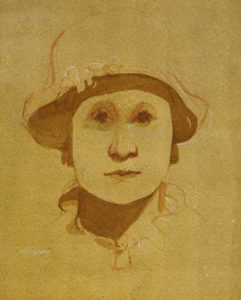
Due to rights restrictions, this image cannot be enlarged, viewed at full screen, or downloaded.
ALEXANDER BROOKS (A.B.) JACKSON
American, 1925 – 1981
Porch Lady, n.d.
Watercolor, chalk, and colored pencil
9 5/16 x 7 9/16ins. (23.5 x 19.2 cm)
© Estate of A.B. Jackson
Gift of the Frederick and Lucy S. Herman Foundation
Muscarelle Museum of Art
1993.068
Explore
Alexander Brooks “A.B.” Jackson was born in New Haven, Connecticut in 1925. As a proven draughtsman in high school, Jackson was admitted to Yale University where he earned a BFA in painting in 1953, and a MFA in graphic design in 1955. Jackson moved to Norfolk, Virginia in 1956 and taught for ten years at Norfolk State University, until he joined Old Dominion University in 1967 as a full professor, becoming the first African American faculty member at the school. Jackson is perhaps best known for his series of paintings entitled, “The Porch People”, which depict his neighbors on their front porches in Ghent, a Norfolk district where he lived. Jackson exhibited his art in many regional shows, including juried competitions; after being rejected because of his race at the Virginia Beach Boardwalk Art show in 1962, he continued to submit his work to the show until finally he was awarded the first prize in 1966. Jackson received significant attention in 1968, after several of his drawings were included in the national tour of an exhibition organized by the Smithsonian Insitution. In 1971, a community fund collected donations to establish an annual A.B. Jackson Fine Arts Scholarship for students at Norfolk State.
“Art is for everyone”
BENNY ANDREWS
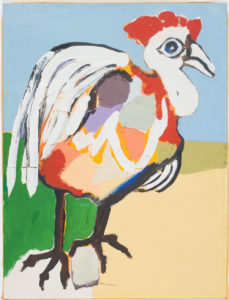
Due to rights restrictions, this image cannot be enlarged, viewed at full screen, or downloaded.
BENNY ANDREWS
American, 1930-2006
Rooster, 1965
Collage on paperboard
19 x 15 ins. (50.6 x 38.1 cm)
© Estate of Benny Andrews
Gift of Jean Outland Chrysler
Muscarelle Museum of Art
1973.439
Explore
Born in rural Georgia in 1930, Andrews was a lifelong artist influenced by his sharecropper and self-taught artist father. After high school he pursued training at the Art Institute of Chicago where he would complete a BFA in 1958. Wanting to create his own style, Andrews veered away from Abstract Expressionism which was the reigning movement of that time. Instead, he developed a technique where he would incorporate fabric and paper into his paintings of expressing childhood memory and political scenes.
Andrews was an advocate for social justice and devoted his life to teaching and promoting the arts for underserved communities and African American expression. Prior to his death in 2006, Andrews illustrated children’s books about the lives of Langston Hughes, W. W. Law, Josephine Carroll Smith, and Civil Rights leader and Congressman John Lewis.
“Every artist wants his work to be permanent. But what is? The Aswan Dam covered some of the greatest art in the world. Venice is sinking. Great books and pictures were lost in the Florence floods. In the meantime we still enjoy butterflies.”
ROMARE BEARDEN
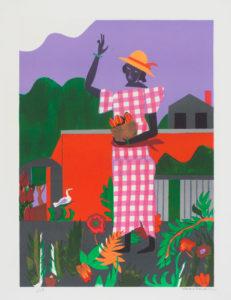
Due to rights restrictions, this image cannot be enlarged, viewed at full screen, or downloaded.
ROMARE BEARDEN
American, 1911 – 1988
In the Garden, 1979
Color lithograph, 7/150
22 x 16 1/8 ins. (56.0 x 40.8 cm)
© Romare Bearden Foundation/Licensed by VAGA, New York, NY
Gift of Lenore Sue Kent
Muscarelle Museum of Art
1980.022A
Explore
Born in 1911 in North Carolina, Romare Bearden moved to New York City at the age of three. After earning a degree in education from New York University, Bearden studied painting at the prestigious Art Students League in the 1930s and 1940s under George Grosz. He joined the Harlem Artists Guild and began his lifelong commitment to the Civil Rights Movement and educating African Americans in the arts. Bearden drew his subjects from personal experience and his deep knowledge of African American history and vernacular culture. His designs, paintings and later collages display a signature style in which both scenery and people are reduced to flattened shapes in apportioned spaces. Bearden’s use of bright colors and improvisational compositions imbue his works with a jazz-like dynamism.
“I work intuitively. I lay down a shape that’s been bugging me; I push it along.”
JOHN L. MOORE
JOHN L. MOORE
American, born 1939
Prospect Park #2, 1987
Charcoal and acrylic on paper
30 3/8 x 43 5/8 ins. (77.2 x 110.7 cm)
© John L. Moore
Purchase, Museum Acquisition Fund
Muscarelle Museum of Art
1988.081
Explore
John L. Moore was born in Cleveland, Ohio in 1939. He received a BFA and MA in painting from Kent State University and has lived in New York since 1985. Moore has both taught and received many appointments as visiting artist at numerous universities in the United States and overseas. This powerful abstraction in black and white was drawn by Moore for a 1987 exhibition of works by five selected artists on the theme of Brooklyn’s Prospect Park.
In an interview with William & Mary’s Miles Chappell (July 1994), Moore said he tried to express the complicated reality of the park, which “is an idyllic, beautiful place, but when darkness descends, things happen.” Moore submitted this drawing in 1988 to the American Drawing Biennial organized by the Muscarelle Museum of Art, and received the First Place purchase award. The Museum acquired additional works from Moore in ensuing years.
“The lord told me: Paint some pictures and put them on your porch.”
ANDERSON JOHNSON
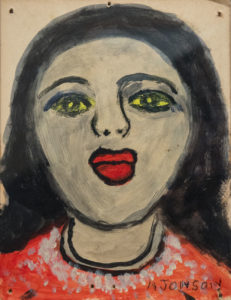
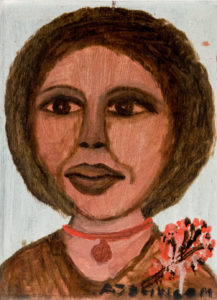
Due to rights restrictions, these images cannot be enlarged, viewed at full screen, or downloaded.
ANDERSON JOHNSON
American, 1915 – 1998
Untitled, both early 1990s
Household paint on cardboard/plywood
Left: 10 1/2 x 8 ins. (26.5 x 20.4 cm)
Right: 12 x 9 ins. (30.5 x 22.8 cm)
© Estate of Anderson Jackson
Gift of the Estate of Marylou D. and Richard H. Sawyer of Hampton, Virginia
Muscarelle Museum of Art
2016.005 and 2016.006
Explore
Anderson Johnson was born in Lunenberg County, Virginia in 1915. At the age of eight, while working on his father’s farm, Johnson had a religious vision that inspired him to become a minister. He preached at many churches and congregations until the 1970s when he was stricken by illness. During his recovery, he began to turn his home on Ivy Avenue in Newport News into a church that he called the “Faith Mission.” The church had makeshift pews and even a small stage where the Elder Johnson would perform gospel music on steel guitar. The walls were covered, floor to ceiling, with hundreds of his paintings, mainly of women’s faces, on salvaged materials he found on the street, from plywood boards to paint can lids. In 1995, Johnson’s church was slated to be demolished as part of an urban renewal project. Numerous local individuals, including William & Mary’s own Grey Gundaker and Joanne Braxton, were instrumental in the preservation of paintings and walls of his home that are now part of the Downing-Gross Cultural Arts Center in downtown Newport News. Johnson’s works are in numerous collections and museums including the Abby Aldrich Rockefeller Folk Art Museum, the Asheville Art Museum and the Muscarelle. They have been exhibited at at the New Orleans Museum of Art and the Corcoran Gallery of Art in Washington, D.C. Recordings of his gospel songs are available through the Music Maker Relief Foundation, which was founded to preserve the musical traditions of the South.
[On photography] “It’s one thing to think of a good idea, it’s another thing to implement a good idea. And it’s a whole process and a whole production to do it. And it takes a kind of self-centeredness to be able to see it through to completion.”
JEANNE MOUTOUSSAMY–ASHE
JEANNE MOUTOUSSAMY–ASHE
American, born 1951
Maya Angelou, 1993
Silver print with hand coloring
10 5/8 x 10 ½ins. (26.9 x 26.6 cm)
© Jeanne Moutoussamy-Ashe
Acquired with funds from the Board of Visitors
Muscarelle Museum of Art Endowment
2015.027
Explore
Jeanne (pronounced “Genie”) Moutoussamy was born in Chicago in 1951. Her mother, an interior designer, and father, an architect, enrolled her in children’s art classes at the Art Institute of Chicago at a young age. Her upbringing and schooling in a creative environment led her to study with renowned street photographer Garry Winogrand at The Cooper Union School of Art in New York. Graduating with a BFA in 1975, Moutoussamy began working as a photojournalist. In 1977, on one of her assignments, she met her future husband Arthur Ashe, the tennis champion. After teaching photography for many years and following the death of her husband, Moutoussamy-Ashe became an activist engaged in social, health and community based projects. She went on to serve as the director of the Arthur Ashe Endowment and, in 1993, created the celebrated book Daddy and Me: A Photo Story of Arthur Ashe and His Daughter, Camera which she wrote for children living with an HIV-infected parent. In this portrait, Moutoussamy-Ashe has captured an image of the dignity and courage of Maya Angelou, poet, composer, journalist, civil rights activist, and author of a classic memoir, I know Why the Caged Bird Sings. Dr. Angelou kept this photograph in her home until her death in 2014. The Muscarelle Museum of Art is proud to have acquired this great portrait of a great poet and
humanitarian.
“God is good.”
ALLEN STRINGFELLOW
ALLEN STRINGFELLOW
American, 1923 – 2004
Red Umbrella for the Youth, 1994
Mixed media on Arches paper
21 11/16 x 28 1/4 ins. (55.1 x 71.9 cm)
© 1994 Allen Stringfellow
Gift of Essie Green Galleries with the permission of Allen Stringfellow
Muscarelle Museum of Art
1996.005
Explore
Born in 1923 and raised by his deeply religious great-grandmother, Allen Stringfellow spent much of his youth at church and attending open-air baptisms in Champaign, Illinois. Stringfellow began his education of the arts during the 1940s at the University of Illinois. He completed his studies at the Art Institute of Milwaukee, Wisconsin. After graduation, he became involved in South Side Community Art Center of Chicago. This center contributed to the education of celebrated artists such as Charles White and William S. Carter, who Stringfellow has identified as his mentors. In the 1950s, Stringfellow opened his own gallery called “Walls of Art” in Chicago. Recognizing that African Americans were under-represented in the art world, Stringfellow’s gallery was intended as a space where African American artists could display their work. As his career continued to develop, he became the General Manager of Armand Lee and Company, one of the most prestigious art framing and restoration companies of Chicago.
“This is my genre… the happiness, tragedies, and the sorrows of mankind as realized in the teeming black ghetto.”
JACOB LAWRENCE
JACOB LAWRENCE
American, 1917 – 2000
Shopping Bags, 1994
Gouache on paper
19 3/4 x 25 3/4 ins. (50.2 x 65.4 cm)
© Jacob Lawrence, 1994
Purchase, Gene A. (W&M 1952) and Mary A. Burns Art Acquisition Fund
Muscarelle Museum of Art
1997.115
Explore
Jacob Lawrence was born in Atlantic City, New Jersey in 1917. At the age of thirteen, in 1930, Lawrence moved to Harlem where he studied at the Harlem Art Workshop and other New York art schools over the course of the decade. Young Lawrence thrived on the intellectual, artistic and social legacies of the Harlem Renaissance. By 1932, Lawrence had begun to work with his first teacher, painter Charles Alston, who introduced him to numerous intellectual and artistic people and encouraged him to address the major themes of African American society. His interest in black history developed into several important series of paintings, including his immigration scenes of 1940 and 1941, Harlem series of 1943 and the John Brown series of 1946. During the depression, he worked many different jobs, but stuck to his art, later teaching and continuing to produce highly colorful and vibrant works until his death in 2000.
“The silhouette says a lot with very little information, but that’s also what the stereotype does.”
KARA WALKER
KARA WALKER
American, born 1969
You Cannot Win, 1995
Ink wash and graphite on white wove paper
35 ¼ x 23 ins. (89.5 x 58.4 cm)
© 2018 Kara Walker
Acquired with funds from the Board of Visitors
Muscarelle Museum of Art Endowment
2013.004
Explore
Born in 1969, Kara Walker received her BFA from the Atlanta College of Art in 1991 and a MFA from the Rhode Island School of Design in 1994. This original drawing by Walker serves as a preparatory cartoon for one of her major works, the etching series, The Means to an End: A Shadow Drama in Five Acts. Walker’s characteristic works depict incidents and stories of unwritten slave narratives in panoramic scenes of silhouetted figures. Through her exaggerated portrayals of both white and African American “types” associated with antebellum America, Walker confronts the injustice and abuses of slavery. In 1997, at the age of 28, she was the youngest artist to receive the prestigious MacArthur Achievement Award.
“No other creative field is as closed to those who are not white and male as is the visual arts. After I decided to be an artist, the first thing that I had to believe was that I, a black woman, could penetrate the art scene, and that, further, I could do so without sacrificing one iota of my blackness or my femaleness or my humanity.”
FAITH RINGGOLD
FAITH RINGGOLD
American, born 1930
The Sunflower Quilting Bee at Arles, 1996
Color lithograph, 94/100
22 1/2 x 30 ins. (57.2 x 76.2 cm)
Faith Ringgold © 1996
Museum Purchase
Muscarelle Museum of Art
2000.023
Explore
Born Faith Willi Jones in 1930, Ringgold grew up in Harlem during the last years of the Renaissance, which yielded rich cultural experiences throughout her youth. Her early interest in art led to her enrollment at the City College of New York where she received a BS in fine art and education in 1955 and a MA in art 1959. Her early art was formal and conventional, inspired by visiting museums in Europe. In the 1960s, she began to portray subject matter informed by the Civil Rights Movement. In the 1970s she also began a literary career with an emphasis on children’s books. It was during this time that she traveled to the Rijksmuseum in the Netherlands and became enamored by 14-15th century Nepali paintings on cloth. These bold and dynamic non-western compositions led her to experiment with textiles and ultimately leading her to quilting. In this work, Ringgold celebrates the African American tradition of quilt making and eight historic women including (from left to right): Madam Walker, Soujourner Truth, Ida Wells, Fannie Lou Hammer, Harriet Tubman, Rosa Parks, Mary McLeod Bethune and Ella Baker. A fictional character, perhaps representative of herself, is Willia Marie Simone which is shown on the lower left. And, in honor of his sunflowers, she portrays Vincent van Gogh at the far right.
“My work is about, I think, responses. My response to what I’m calling GROUNDINGS. A process of creating objects that relate to but are not reproductions of structures, houses mainly lived in now or abandoned that served as home or an emotional grounding.”
BEVERLY BUCHANAN
BEVERLY BUCHANAN
American, 1940 – 2015
Cabins at State College (S.C.), 1997
Oil pastel on paper
60 1/4 x 45 ins. (152.0 x 114.3 cm)
© Beverly Buchanan
Purchase, Gift of Alfreda Beresford Topping Lowe
Muscarelle Museum of Art
1997.102
Explore
Born in North Carolina in 1940, Buchanan completed training in public health and later re-focused her attention on painting rather than medical school as she originally intended. In 1971, she enrolled at the Art Students League in New York City where she studied with Norman Lewis. She received further encouragement through the mentorship of Romare Bearden. In 1977, Buchanan moved to Georgia where she fell in love with the vernacular architecture of the south and especially the tumbledown rural shacks, a holdover memory of her youth in the Carolinas. She found a vivacity and dynamism in these humble dwellings that were often composed of scrap and repurposed materials. In this large work, Buchanan evokes that dynamism through her bold colors, angularity and staccato marks.
“I’ve learned to ‘get rid of rules’ … which is the best form of creation.”
SAM GILLIAM
SAM GILLIAM
American, born 1933
Untitled, 1998
Mixed media construction
20 1/2 x 21 1/2 ins. (52.1 x 54.6 cm)
© Sam Gilliam
Purchase, Muscarelle Museum of Art Associates
1998.021
Explore
Born in Tupelo, Mississippi in 1933, Gilliam graduated with a MFA from the University of Louisville in 1961. He soon moved to Washington D.C. where his wife, Dorothy Butler, became the first African American employed by The Washington Post. At age eighty-three, Gilliam is considered the leader among African American artists. He has designed numerous public works for metro stations and airports. Gilliam became one of the key artists from the Washington Color School; a group of abstract painters in Washington, D.C. from the mid-1950s through the 1960s. Gilliam’s style alternates between the “geometric” and “lyrical” abstraction that grew out of Color Field painting that replaced Abstract Expressionism. Gilliam stands out for his irregular canvases and bold geometric patterns and shapes. His compositions project a visual syncopation that evokes jazz music or a patchwork effect reminiscent of a crazy quilt.
Referring to her earlier work [The Liberation of Aunt Jemima, 1972], “I had this Aunt Jemima, and I wanted to put a rifle and a grenade under her skirts. I wanted to empower her. I wanted to make her a warrior. I wanted people to know that black people wouldn’t be enslaved by that.”
BETYE SAAR
BETYE SAAR
American, born 1926
The Fire Next Time: Blow Top Blues, 1998
Color lithograph, hand–coloring, and collage, artist’s proof 6
27 1/8 x 22 1/2 ins. (68.9 x 57.15 cm)
© Betye Saar; Courtesy of Michael Rosenfeld Gallery, LLC, New York, NY
Purchase, Thomas
W. & Lolita Gayle Memorial Fund
Muscarelle Museum of Art
2001.030
Explore
Betye Saar (pronounced Sahr) was born in Los Angeles in 1926 where she attended the University of California before pursuing graduate studies at several universities. Now in her nineties, Betye Saar has been awarded honorary doctorate degrees by the California Institute of the Arts, Massachusetts College of Art, Otis College of Art and Design, and San Francisco Art Institute. Saar works in a multitude of media including assemblage and sculpture as well as installation work with incorporated sound. This work is part of her “new liberation” series where she explores stereotypes with an emphasis on derogatory images such as the “mammy” personified by the commercially known “Aunt Jemima.” Here the bandana on Aunt Jemima’s head explodes in fire and rage clearly expressing Saar’s feelings on racist images.
“I get everything that satisfies my soul from bringing together objects that are in the world, manipulating them, working with spatial arrangements, and having things presented in the way I want to see them.”
FRED WILSON

Due to rights restrictions, this image cannot be enlarged, viewed at full screen, or downloaded.
FRED WILSON
American, born 1954
Drop, Dripped, 2003
White and black glass, ed. of 20
A: 24 x 4 1/2 x 12 1/4 [diam] ins. (60.9 x 11.4 x 31.1 cm);
B: 12 x 12 1/2 x 1 3/4 ins. (32.7 x 30.4 x 4.5 cm)
© Fred Wilson
Acquired with funds from the Board of Visitors
Muscarelle Museum of Art Endowment
2017.007, A–B
Explore
Wilson was born in Bronx, New York, in 1954 where he still lives and works today. He earned a BFA from Purchase College, State University of New York and has been awarded honorary doctorates from Northwestern University and Skidmore College. He was awarded the MacArthur Foundation Genius Grant in 1999 and the William & Mary Cheek Medal in 2009. Drop, Dripped was created in an edition of twenty in 2003, the same year Wilson represented the United States at the Venice Biennale. This playful work shows a slowly advancing white drop before it dissolves into a black globule with added minstrel-like eyes that allude to stereotypes of African Americans in visual culture. The notion of the white and black droplets is perhaps a disguised allusion to the bitterly ironic “Optic White” scene in Ralph Ellison’s classic novel Invisible Man (1953) in which the protagonist is ordered to mix black and white paints to create the brightest, purest white paint possible.
Prince believes his works to be an “open letter” to American society calling them, “to acknowledge their role within the fabric of the American family and to redress race, representation, and education with a new raiment woven of respect, truth and equality.”
STEVE PRINCE
STEVE PRINCE
American, born 1969
In the Line of Fire: Norfolk 17, 2004
Linoleum print, 4/10
49 1/2 x 36 ins. (125.7 cm x 91.5 cm); Framed: 62 5/8 x 48 3/8 ins (159.1 x 122.7 cm)
© Steve A. Prince
Purchase, Acquired with funds from the Gene A. and Mary A. Burns Bequest
Muscarelle Museum of Art
2010.076
Explore
A native of New Orleans, Steve Prince was born in 1968. He received his BFA from Xavier University of Louisiana and an MFA from Michigan State University. A tireless educator and self-described “art evangelist”, Prince’s works have been shown internationally in group and solo exhibitions. He has taught at numerous schools and colleges including William & Mary, summer 2017, as part of the 50th anniversary commemoration of W&M’s first African American residential students. Since 2014, Prince has served as art instructor for the Muscarelle Museum of Art’s Cultural Arts Experience which is an annual program sponsored by the Greater Williamsburg Women’s Association.
Working primarily in drawing and printmaking, Prince’s works are laden with cultural and spiritual iconography. In the Line of Fire: Norfolk 17 addresses the integration of schools that took place in Norfolk, Virginia in 1958 following the landmark 1954 Brown vs. Board of Education case led by Thurgood Marshall. In this work he alludes to Van Gogh’s Starry Night “ intended to visually show the turbulence of the times.” The checkered path “symbolically represents the crossroads.” The title suggests the dangers that the students faced and among many other signs, the initials “ST” on a cufflink alludes to the segregationist Strom Thurman who actively spoke out against the Civil Rights Act.
“The pieces always feel like children to me, in that they have their own personalities and their own needs and desires, and their own abilities.”
ALISON SAAR
ALISON SAAR
American, born 1956
Lost Boys, 2008
Etching with hand–applied ribbon threaded through Rives BFK wove paper, ed. 14/16
23 7/8 x 35 7/8 ins. (60.8 x 89.7 cm)
© Alison Saar
Acquired with funds from the Board of Visitors
Muscarelle Museum of Art Endowment
2017.001
Explore
Born in 1956 to painter and art conservator Richard and assemblage artist Betye Saar (pronounced Sahr), Alison received a BA in art history in 1978 from Scripps College in Claremont, California and a MFA from the Otis Art Institute in Los Angeles. Inspired by her early exposure to art from different cultures, including Outsider art, Saar’s work often deals with difficult subjects such as enslavement and the African diaspora. This print by Saar refers to the “Lost Boys of Sudan”, a term given to the thousands of orphans that were killed or displaced during the second Sudanese Civil War (1983-2005). Based on her sculpture of the same name, the faces represent the boys and the shoes are emblems of the epic journey that the traumatized boys would make to find relief camps.
“When the ironing board is horizontal, it represents a ship. When it’s vertical, it’s a shield. And the iron, when the point is up, represents a house, and when the point is down, a face.”
WILLIE COLE
WILLIE COLE
American, born 1955
Savannah, Dot, Fannie Mae, Queen, Anna Mae
from the suite Five Beauties Rising, 2012
Intaglio and relief, ed. 7/9
63 1/2 x 22 1/2 ins. (162.6 x 58.4 cm)
© Willie Cole and Highpoint Editions
Acquired with funds from the Board of Visitors
Muscarelle Museum of Art Endowment
2017.003, 1–5
Explore
Born in 1955 in New Jersey, Willie Cole was close to and inspired by his mother and grandmother who figured prominently in his upbringing. Tools of domesticity such as irons and ironing boards in his work integrates with African imagery and culture that he researched while at the School of Visual Arts in New York. In this suite of prints entitled Five Beauties Rising, the ironing board imagery has a number of associations that are a product of these joint influences as well as a nod to the concept of “ready mades”; made famous by the Dadaists and used expressively throughout Cole’s larger body of work. Each image in the suite is given a title that recalls traditional names of southern and African American women. By utilizing shapes reminiscent of the trans-Atlantic slave ships such as the British made “stowage Brookes”, and creating distressed surfaces, Cole intends to evoke the painful history of African Americans and slavery.
“Although idea and form are ultimately paramount in my work, so too are chance, accident, and rawness.”
MARTIN PURYEAR
MARTIN PURYEAR
American, born 1941
Diallo, 2013
Aquatint and drypoint, 12/50
Acquired with funds from the Board of Visitors
23 3/4 x 17 5/8 ins. (60.3 x 44.8 cm)
© Paulson Fontaine Press
Acquired with funds from the Board of Visitors
Muscarelle Museum of Art Endowment
2015.010
Explore
Born in 1941 in Washington, D.C., Puryear received his BA in fine art from Catholic University of America and a MFA in sculpture from Yale University. In between his university studies, Puryear went with the Peace Corps to Sierra Leone, where he learned traditional woodworking skills from the local populace. This experience would later inform his work as a post-Minimalist sculptor. Puryear’s works combine manual skill and traditional wooden building structures with varying degrees of abstraction. Puryear’s designs to create a dynamic sense of geometric and organic opposites and conflicting effects of practicality and fantasy. His highly influential sculptures are frequently displayed
in major museums and exhibitions.
About
Building on the Legacy: African American Art from the Permanent Collection
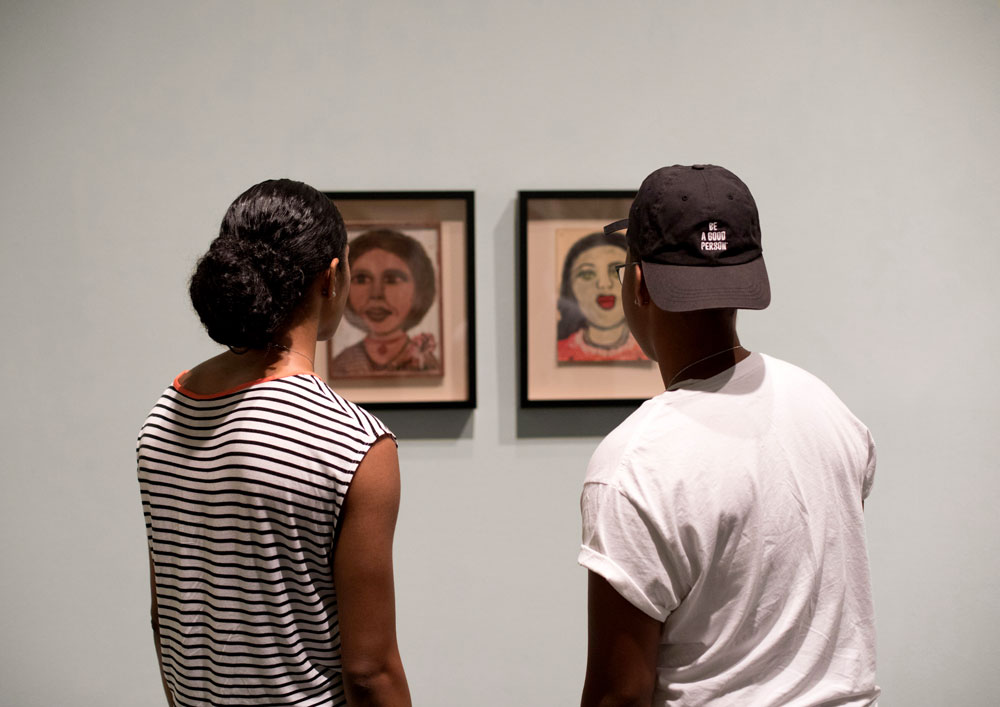
Andrew Uhrig W&M ‘20
Throughout 2019, as part of American Evolution™, William & Mary, the Commonwealth of Virginia including the Jamestown-Yorktown Foundation, Virginia Museum of Fine Arts, and others will be holding special exhibitions, lectures and symposia to examine and recognize the important cultural legacy that African Americans have brought to Virginia and beyond as well as explore the difficult journey towards equality.
Introductory animation adapted from Willie Cole’s Five Beauties Rising.
WILLIE COLE | American, born 1955 | Savannah, Dot, Fannie Mae, Queen, Anna Mae
from the suite Five Beauties Rising, 2012 | Intaglio and relief, ed. 7/9 | © Willie Cole and Highpoint Editions |
Acquired with funds from the Board of Visitors Muscarelle Museum of Art Endowment | 2017.003, 1–5






